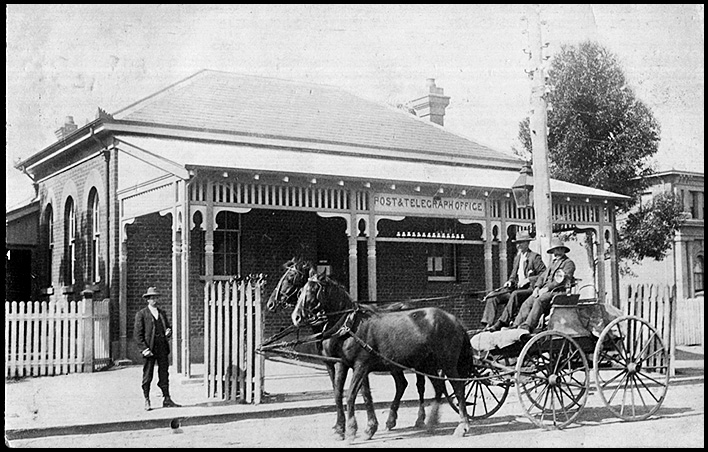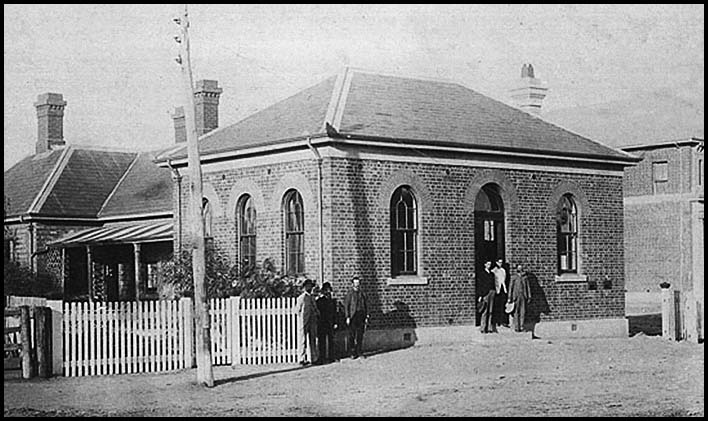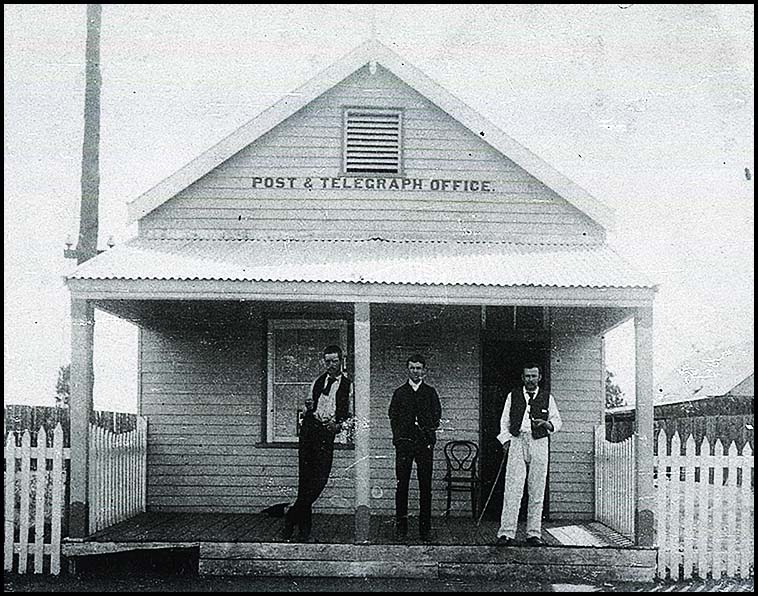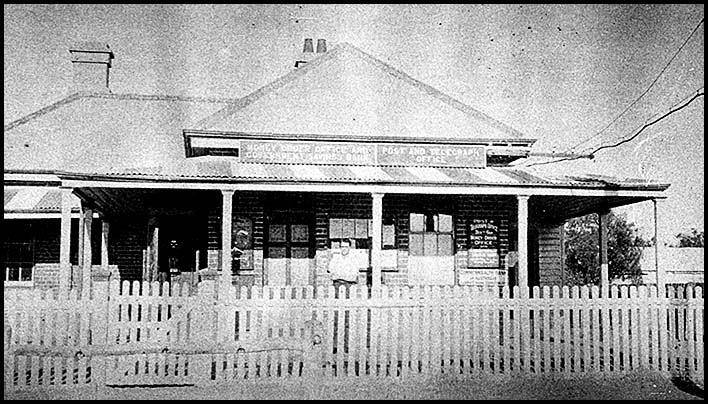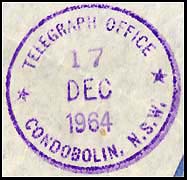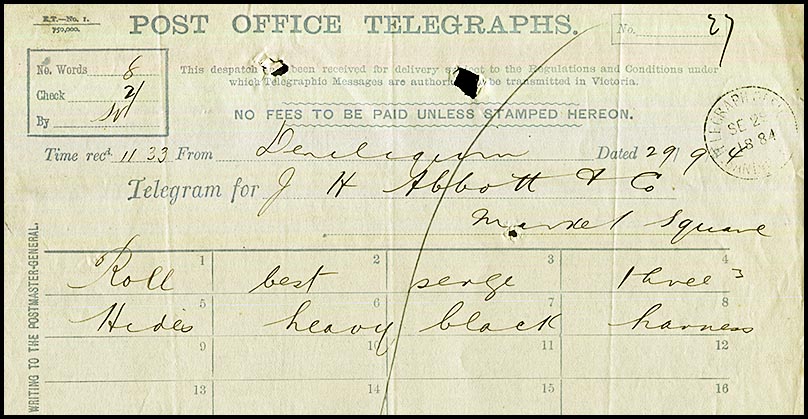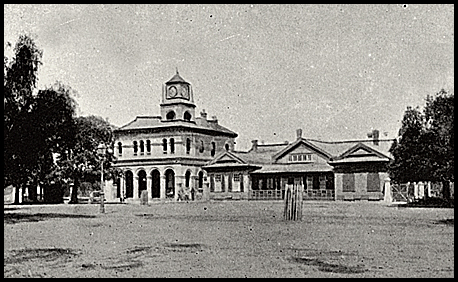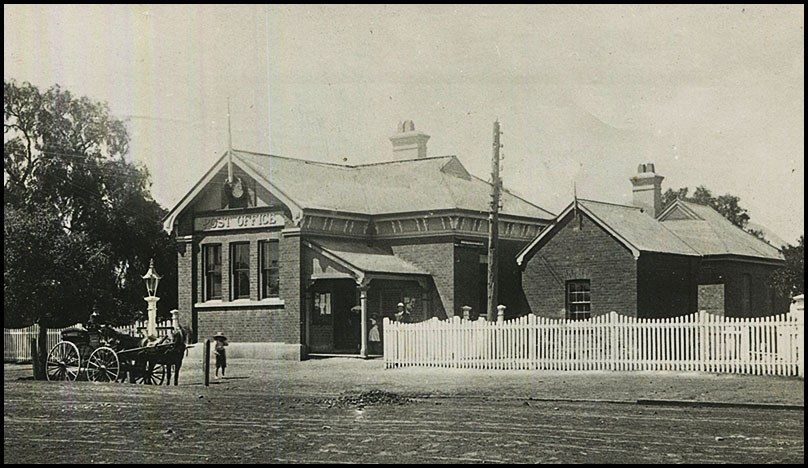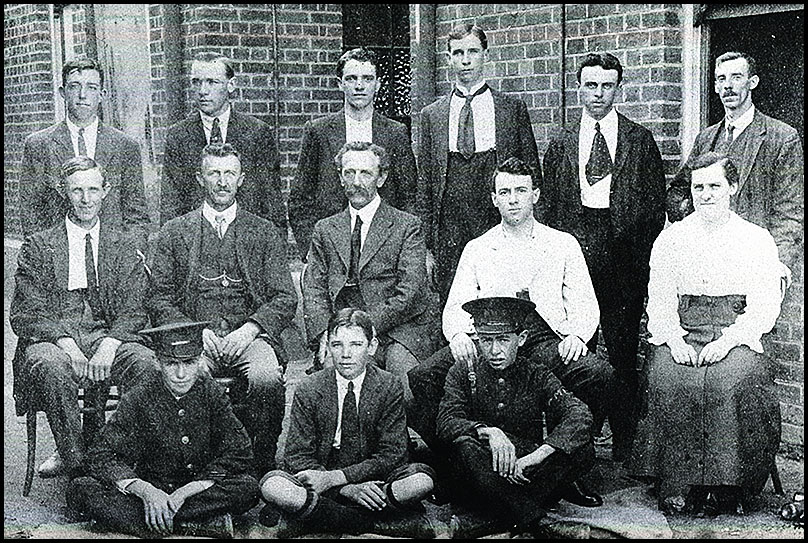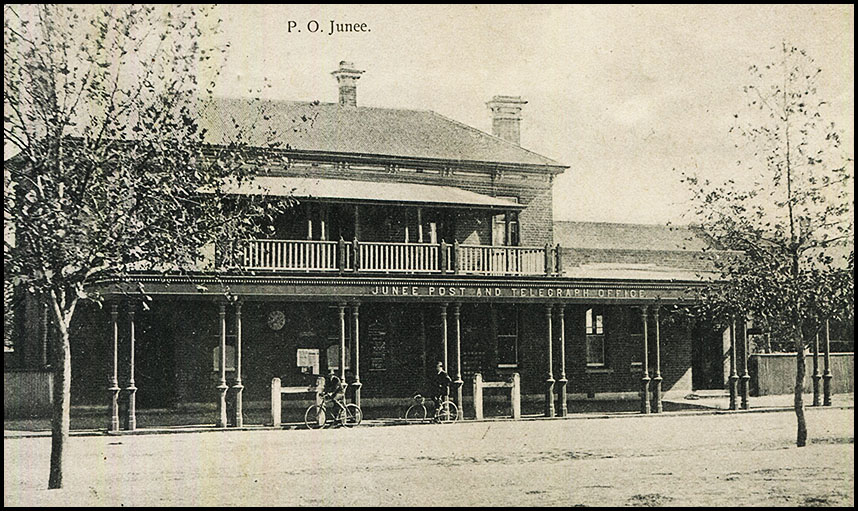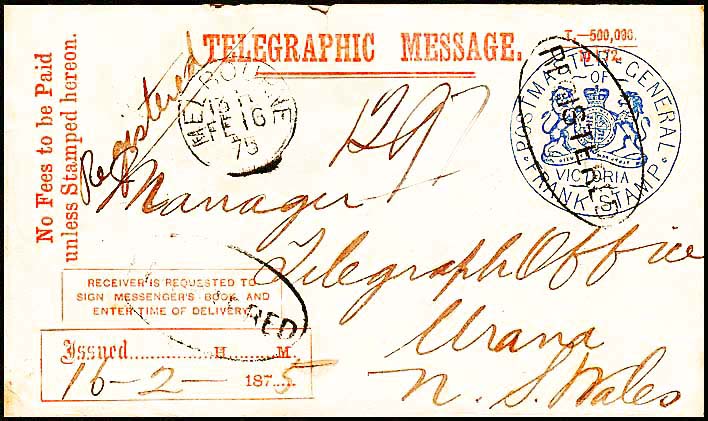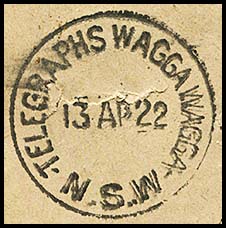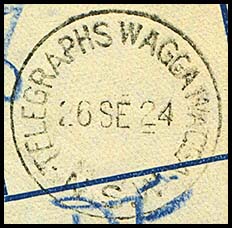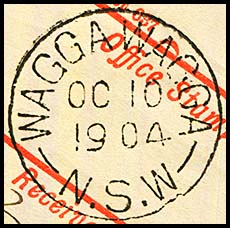Telegraph Offices in the Riverina-Murray region.
.
- Australia 1901-1988
- New South Wales
- Overview of NSW
- Telegraph lines
- Telegraph Offices
- Date stamps
- Forms
- Envelopes
- Instructional annotation
- Collect
- Delayed
- Free
- Immediate Urgent
- Reply paid
- Rates
- Stamps
- 1871 Telegraph stamps
- 1885 proposal
- 1893 proposal
- Queensland
- South Australia
- Tasmania
- Victoria
- Western Australia
- International
- Special aspects
The following stations were included on the Riverina-Murray lines. Some Offices listed were also on the other lines but are included here when there was an overlap between lines.
| Albury | Balranald | Berrigan | Bethungra | Carrathool | Corowa |
| Deniliquin | Euston | Griffith | Hay | Jerilderie | Junee |
| Lalalty | Lang's Crossing Place | Moama | Moulamein | ||
| Narrandera | Urana | Wagga Wagga | Wentworth | Yass |
Telegraph Offices in this region were along or near the first line to South Australia from New South Wales.
Public wharves were established by proclamation on 13 April 1872 along the Murray River at Corowa, Mulwala, Tucumwal, Moama, Swan Hill, Euston and Wentworth.
These establishments reflect the economic activity which was being generated in the area and so the increased need for telegraphic communications.
Early usage. The earliest indication of the operation of the Balranald Telegraph Office is a delivery envelope sent on 4 November 1872 from Echuca, Victoria to the TELEGRAPH STATION MASTER at Balranald. |
|
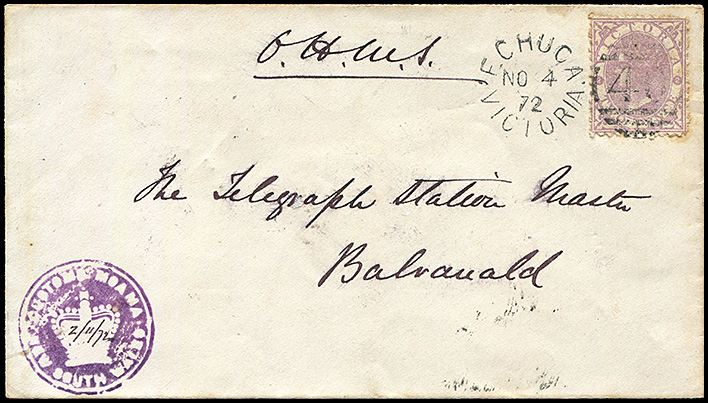 |
Echuca to Balranald 4 November 1872. OHMS cover addressed to the Telegraph Station Master. Has a 2d dull lilac mauve De La Rue design. Cover had crossed the Murray River from Moama to Echuca on 2 November and passed the Customs inspection as shown by the NSW intaglion Crown hand stamp. Very rare. Provenance: Besacon Collection (Corinphila May 2018 Lot 3464). Johnstone. |
|
A Telegraph Office was opened at the Railway Station on 15 April 1878. The Post Office, which had opened on 1 December 1875, was moved to the Railway Station on 6 July 1878. As a semi-official office, all parts were removed from the Railway Station on 1 December 1909. The Wodonga and Towong Sentinel of 10 October 1885 reported the following: "Mr G. A. Sala, in one of his descriptive articles, asserts that he saw Sydney in a dream. If the Governor, or any other exalted official, should chance to visit Bethanga and desire to inspect the Government offices and institutions, it would be well that he, like our late distinguished visitor, should see them in a dream. Viewed through such a medium what he would perceive would naturally differ from the reality ... The Post Office, also a Government building, was as creditable to the representatives of the district as the other erections His Excellency was called upon to admire. The Telegraph Office, situated in the same building, also resounded merrily with the "click" of the instrument and His Excellency took advantage of the occasion to wire to Yackandandah that he intended going to Wodonga instead of visiting that town. But remember all this was in a dream. In reality, the State school is held in a church which costs the Education Department more in rent than would suffice for a decent edifice. The majesty of the law displays itself in a private rented building and so also with the mails. As for Telegraph Office, much as it is required, and notwithstanding that the wires almost pass the place, alas there is none. Indeed the only permanent Government institution is the cemetery. The Bethanga people have reason to complain. They have in many cases made their homes in the mountain township, and should be adequately provided with proper Government buildings. Should the authorities feel doubts as to the permanency of the place, it is quite possible to erect buildings of a good and sufficient but temporary character. It is not at all fair to Bethanga that its population should be put off with the inferior rented structures now evidently considered good enough for the residents". |
|
A Post Office opened on 7 March 1861, closed on 30 September 1865 and then reopened on 7 March 1866. The Telegraph Office opened on 1 July 1878 and then combined with the Post Office on 1 November 1878. The Sydney Morning Herald of 4 August 1877 commented on Booligal in the following (non-telegraphic) terms.: "We are neglected for want of proper representation in Parliament. What better proof can be given in the state of the Wilcannia road hence than the road superintendent coming here from Hay and returning again without proceeding on his journey, and that solely on account of bad roads. Travellers are getting tired of being from six to twenty-four hours behind in the mail coach on account of non-fulfilment of the Government's promise to build bridges". |
|
|
The Telegraph Office opened on 8 August 1882 at least at the Railway Station. Personnel: In December 1889, Mr. William Newton was Telegraph Master. |
| Condobolin.
The Telegraph Office was opened in 1878 and merged with the Post Office on 12 August 1878. The Post Office had been opened on 1 July 1858. Condobolin is the border of the North Central and South West regions but its position along the extension of the Bathurst-Forbes line classifies it as South West for these purposes. Three formats were used for date stamps for the Telegraph Office. |
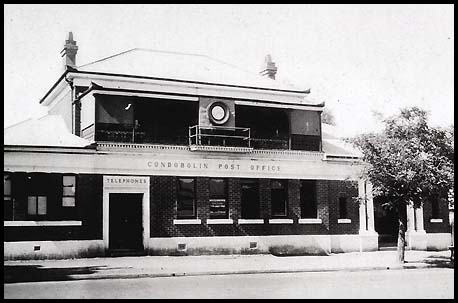 |
|
|
|
|
|
Used on AA-DO-3C. |
|
|
22 August 1980. | |
| Corowa.
Corowa is located on the N.S.W. bank of the Murray River on the opposite side to Wahgunyah in Victoria. The Telegraph Office opened 21 January 1873 and combined with the Post Office on 1 September 1873 (TO BE CONFIRMED). The Post Office had opened on 1 January 1861. Corowa was one of the "border towns" - with Wahgunyah - and so had an ambiguous position for the calculation of cost for telegrams. The difficulty was emphasised with rates set for under 15 miles. This ambiguity was not resolved until 1939. It was also a "private town" - see elsewhere. |
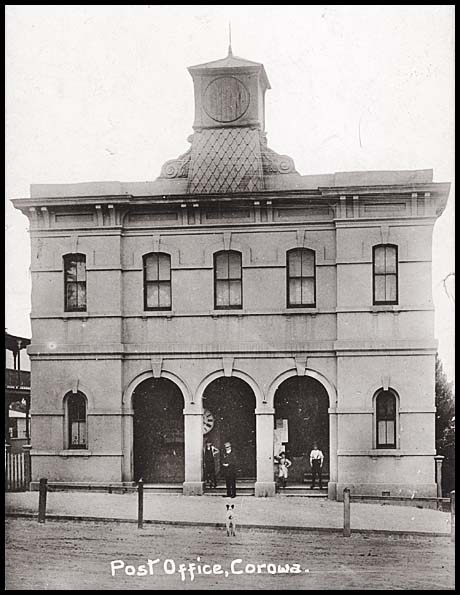 Corowa P&T Office with spire but before clock at top installed. |
|
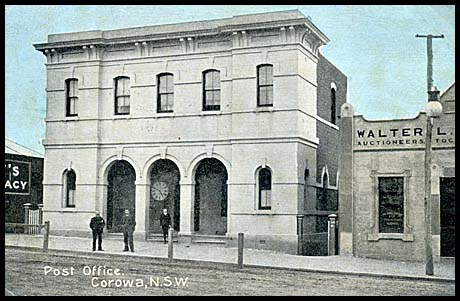 Corowa P&T Office about 1900. Spire not yet constructed. |
||
The Albury Banner of 23 May 1874 reported on the state of affairs about seven months after the amalgamation: "I observe in the Age a paragraph anent the impecuniosity of the Post Office authorities at Albury, stating that they were unable to cash a post-office order for ten pounds, and reflecting somewhat upon the management at the head of the department in Sydney. The people of Corowa have, however, more than this to complain of. Only fancy a Telegraph Office established here over twelve months without a single form on which to transcribe the messages and a Post Office destitute of postage stamps for upwards of three weeks. One of our enterprising townsmen, I am informed, endeavored to remedy the inconvenience arising from this state of things, by sending ten pounds and an order for stamps to the Postmaster-General, but as yet he has received no reply. There is evidently great neglect somewhere, and it is to be hoped that the Chief of the Circumlocution Department in Sydney may be informed of the fact". The Ovens and Murray Advertiser of 20 June 1878 reported "With a view of affording increased accommodation at Corowa for the line of telegraph and postal business, the Government have resolved to erect a new building sufficiently capacious to meet all requirements, to which end they have purchased from Mr. Levin a suitable site". In June 1880, a contract was agreed with Mr. Wm. Squire to construct a new Post and Telegraph Office at Corowa. The North Eastern Ensign reported: "The telegraph operator at Corowa, Mr. T. L. Miller, has been arrested on a charge of embezzling a sum of £15 15s 9d of public moneys and forwarded under police escort to Sydney. This official, who was expected to be honest and maintain the position of a gentleman, only received £100 per annum. It is not long since an operator was transferred to the district, but the order was countermanded in consequence of the young man having but a Flemish account of his receipts to give his successor". Personnel: April 1874 (about 7 months after the amalgamation): "Mr. T. L. Miller, late Post and Telegraph Master at Corowa, arrived in Yass, in custody, on Saturday, en route for Sydney, charged with embezzlement. He left Yass yesterday for Sydney with the police escort". The Albury Banner gave the following details: "Mr. T. L. Miller, our Post and Telegraph Master, has been arrested for embezzling money, the property of the Government, and remanded to Sydney for examination. The specific charge refers to a sum of £15, but the extent of his defalcations is understood to be very much larger, in fact about £100 more or less. Our local paper (the Chronicle) in an article headed "a fable" in last Saturday's issue, which savors strongly of maudlin sympathy, makes a wholesale charge against the inhabitants of Corowa of having helped Miller to his disgrace by having imposed on his overgenerous and yielding disposition, and in various ways leading him to dispose of money which was not his own. Whilst admitting the possibility of there being some amongst us who might perhaps be capable of this kind of conduct, it is, I think to be regretted that the writer of the "Fable" did not first satisfy himself of the truth of his statement and then boldly expose the guilty persons rather than in somewhat ambiguous terms libel a whole township. My own impression anent Miller's case is that the young man was quite unfit to be placed in any responsible position; he possessed any amount of the naviter in modo, but none of the fortiter in re, and in brief was hardly fitted to have been loosened from his nurse's apron strings". December 1874: Mr. Frank Russell was appointed Station Master on inter-change with Mr. Richard Mills who was transferred to Albury. May 1876: The Albury Banner reported a letter dated 8 May: "Sir,—With reference to the communication you forwarded on behalf of Messrs. Reginald Hare, J.P., E. J. Glascodine, Alexander Anderson, J.P., and others, in favor of the retention of the present Post and Telegraph master at Corowa, I am directed to inform you that the Postmaster-General considers it his duty, in the interests of the public service, to adhere to his former decision in respect to the removal of the officer in question from Corowa. I am to add that the removal will not involve any loss of salary to Mr. Russell.—I have the honor to be, Sir, your most obedient servant, J. W. LAMBTON, Secretary.—Geo. Day, Esq.,M,P.". No other information can be found about this. Perhaps an interesting link between Miller and Russell. March 1879: Mr. Lindsay Browne who, for the last two years, had acted as an assistant operator in the Corowa Telegraph Office, was promoted to Operator at Grenfell. Mr Browne was to leave immediately for his new sphere of labor and carried with him the good wishes of all his Corowa and Wahgunyah friends. |
||
| Deniliquin.
The first Telegraph Office was opened by a private company together with the Telegraph Office at Moama on 24 March 1859. See the full story elsewhere. The second Telegraph Office opened on 1 August 1861 and merged with the Post Office on 1 January 1870. The two offices then separated on 1 August 1875 before recombining again on 29 June 1901. |
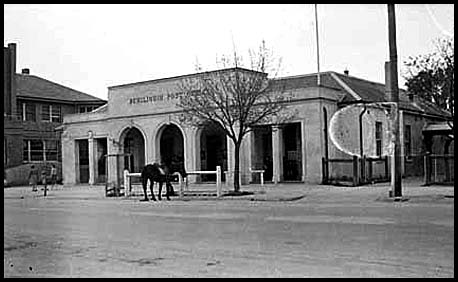 Deniliquin P&T Office taken about 1946. |
|
Tenders for called in the Gazette for the erection of a single building at Deniliquin in July 1862 containing both a Telegraph and a Post Office. The combination was a new policy adopted by the Government. On 22 August, the Gazette announced the tender had been awarded to Mr. Walter William Moore. The request for tenders was readvertised on 13 March 1863. The Pastoral Times of 8 January 1870 explained the implications of the amalgamations being implemented across the NSW network, where possible, for the very important Deniliquin office: "AMALGAMATION OF DENILIQUIN
POST AND TELEGRAPH OFFICES. The offices are under the superintendence of the Telegraph Master, Mr. Kraegen, assisted by Mr. Craig and Mr. Manners, both very active and very obliging persons. Mr White, the late Postmaster, has left the service, and is going to Sydney, where we hope that he may get another appointment in some department of Government where his services can be made available. Mr. Casey goes with him, he having declined to accept 6s. per day offered to him by the Postal Department as a temporary situation. The change has been brought about under the eye of Mr. Moyes, postal inspector for the district, who has been here for a few days for that purpose. Formerly it took five men to work the Post and Telegraph Offices here — now three are found sufficient though a message boy may have to be added as there are three telegraph instruments in operation here - one line in connection with Sydney, a second with Melbourne and a third with Adelaide, Deniliquin is a repeating station. The saving in amalgamation will be about £200 per annum and, if the old Telegraph Office is let for £60 a year (the sum offered for it), the saving will be £260 per annum; then there are £40 per annum saved for the rent of the "temporary" Post Office, - which was temporary for seven years - making it altogether £300 per annum. The new and amalgamated official place has a business-like air about it—the building is well designed and extremely commodious, the Post and Telegraph Office being in one capacious room. The place of delivery is on the northwestern side of the building, cut off altogether from the doors where the mails are received; consequently there is no justification for anyone not sworn in entering the main office room We hope that the head of both departments (Mr. Kraegen) will not, under any pretext, permit visitors to go inside of the delivery office. He will, doubtless, see to this being observed. The new arrangements may not work so smoothly at first and the public here, interested in the regularity of the office, are asked to be lenient only for a brief time. Eventually the united office will work harmoniously and effectively. Let them have a fair trial — the Minister who boldly faces the storm which any comprehensive scheme of retrenchment is sure to call into action deserves, in this respect, the best support which the Press can give to him". A follow-up to this article was printed in the Pastoral Times of 26 February 1870. Very soon after, Mr. Kraegen left Deniliquin and Mr. Olsen from Moulamein acted in his position supported by Mr. Robinson who was being retrenched from Forbes. In March 1870, Mr Olsen, having discharged his duties very efficiently during the last fortnight, was to return to Moulamein towards the end of the month. But there were still changes in the wind. The The Pastoral Times of 1 February 1875 reported: "The plan of amalgamation of the Post and Telegraph offices does not appear to have been answered in Deniliquin, however suited it may be for small townships. We hear that the Deniliquin Post and Telegraph offices will soon be separated. The demands on the telegraph operator's time, twelve or thirteen hours a day before the nightly mail arrives, are not likely to fit him for Post Office duties at 10:00 p.m. There is also an objection to the union of the two offices in an important town like Deniliquin, where there is too much wholesale as well as retail business going on. The Telegraph Office is a repeating office. The objection to the union of the two offices does not, that we know of, proceed from any dislike to the officers, or any of them, but it is thought by the public that the Post Office requires the supervision of an officer who can regard its duties as of paramount importance, and not as subservient to the telegraph department. Overlanders and others having large commercial transactions, often arrive at Deniliquin after the usual office hours (4:00 p.m.) when these parties require a little indulgence at the hands of the Postmaster which would not be expected of him if he were the Post and Telegraph Master. For the last four years, the union of the offices has had a fair trial, and while the Postmaster was under the Telegraph Master, the system has hardly worked satisfactorily. The officers could not always agree, hence every two years or so we have a change of postmasters, which is in itself highly objectionable, inasmuch as it takes several months to so instruct the postmaster as that he shall know the divisions of the districts to which he has to despatch letters and papers. These are among the reasons that make the public clamorous for a division of the offices. We may again refer to the subject, but we take this opportunity of acknowledging the invariable courtesy and punctuality displayed by the offices of the united departments for the last three or four years. We express hopes that their interests individually or collectively will not suffer by the separation of the offices. At the same time, we hope it will not be considered out of place on our part if we state that we think all the officers in Deniliquin Post and Telegraph Department are underpaid, a statement which we think the public here will endorse". 2. The role as a repeater station. With all of these lines coming through Deniliquin, the role of the Telegraph Office was expanded in June 1867 to encompass duties as a "repeater station". Consequently an assistant operator was appointed there, the work being too much for one person. The centre of the pastoral districts of New South Wales then had a line of telegraph through it. The Pastoral Times was able to publish news in forty-eight hours from "Fort Bourke" and, as a line was soon made to that place - namely to the head of the Darling River, residents around Deniliquin would be able to receive daily news from Bourke. By 1887, the volume of traffic through the Deniliquin Telegraph Office was estimated at about 1,000 to 1,200 messages each day. It was so large that a duplex instrument had to be installed. 3. The building as a functional office. "The Deniliquin Post Office is now a very busy place and Mr. White, the Postmaster, about the hardest worked man in the town. His labour appears to be nearly continuous, night and day, with a little interval of rest on the Sabbath. On the same evening we have mails from Sydney, Albury, Wagga Wagga, Hay and Melbourne tumbling in within some three or four hours of each other and having to be sorted and dispatched over the district before the small hours of the next morning have passed. Altogether Mr. White's billet contrasts very unfavorably with the amount of labor demanded from some other officials who are in our mind's eye. While referring to local postal matters, we may state that the business is carried on still in a room at the Royal Hotel and, although the fittings for the one apartment in the Telegraph building intended for the new Post Office have arrived from Melbourne, they are of the most meagre character and unless supplemented largely by convenient additions which anyone acquainted with Post Office work would readily perceive the necessity of but which the Postmaster-General apparently does not - Mr. White will be compelled, when he removes, to carry with him the various gin and pickle cases which, up to the present time have done duty for pigeon holes and boxes in sorting the mails. Besides this, as far as is known at present, there is to be only one room in the new building connected with the Post Office, while the other three, with the central hall, are to be in the possession of the Telegraph officials. Now, had this arrangement been about reversed, the convenience afforded to the two departments would have borne some tolerable relation to the business wants of the two but, as it stands, it is simply absurd. The Official who has to attend to his duties at occasional intervals throughout the night will have to reside off the premises while he who shuts up at half-past five pm and opens at nine on the following morning has quarters provided under the government roof. Mr. Cracknell's subordinates appear to be very well attended to by their chief, while those of poor Major Christie, seem unable to obtain the requisite conveniences for carrying on the public business entrusted to them. Under such effete management is it any wonder that the Post Office don't pay?" (Pastoral Times 5 March 1864). The Pastoral Times of 31 January 1862 reported that "In the forenoon of Wednesday, while Mr. Beattie, the telegraph station master at Deniliquin, and Mr. Scott, the lineman, were in the act of lifting a carboy of sulphuric acid on to a table for the purpose of withdrawing some of its contents, the vessel suddenly broke, emptying the acid over them and severely burning both. Mr. Scott imprudently ran into a lagoon near the river. Both he and Mr. Beattie are confined to bed and likely to be unfit for their duties for some time to come". On 26 October 1878, the Deniliquin Municipal Council tabled two very important letters - the first from the Colonial Secretary in which he stated "re town clock - the clock at Wagga supplied by Government was erected at the Telegraph Office and not the Town Hall (and the second letter) from R. Barbour relative to same matter to the effect that there were 110 precedents for the Government supplying municipal bodies with town clocks, but he would endeavour to induce Parliament to vote a sum of money for this purpose". Immediately after: "The Mayor, referring to the question of the town clock, said it was immaterial whether such was placed at the Town Hall or on Government Offices. If Government would grant a clock, they might place it where they pleased. The Town Hall had merely been suggested as the most suitable place". (No wonder he got the Big Job!!). |
|
|
About 1859-60: A young man named (Mr. Edwin Jas.) Welch acted as a telegraph messenger at Deniliquin. He must have been with the private office. A summary of his incredible career - including him helping to search for the lost explorers Burke and Wills - is provided elsewhere. September 1861: Mr. Edward D. Scott was appointed Electric Telegraph Lne Inspector at Deniliquin. November 1864: Mr. J. J. Roberts was appointed as Telegraph Line Inspector and Operator - BUT WAIT THERE IS MORE:
June 1867: Mr. E. Manners was appointed Line Repairer.
January 1868: Mr. James R. Craig was appointed as an Operator in the Electric Telegraph Office. January 1869: Mr. Charles K. Kraegen was transferred to be Telegraph Station Master after fulfilling his similar role at Albury. 6 November 1869: AMALGAMATION. For self-reliance there is no better department in the Government than that in the Telegraph Office - secrecy is so indispensable that any violation in this respect would be most damaging to the office and to the person who may be guilty of a breach of trust. In this respect, the Telegraph Office is a fine school for punctuality, secrecy and despatch. Whether in Government employ, or in any other service, we feel satisfied that Mr. Craig will be an acquisition as a promising young man. He is son of the Rev. Mr. Craig, Presbyterian Minister, of Wagga Wagga. We wish the young man well, and we sincerely hope that he may fall into good hands as employers to whom he will, we believe, be all that is desirable". The above report on the amalgamation of the two offices suggests that maybe Mr. Craig did not have to leave after all. BUT... March 1870: Mr. Olson, of the Moulamein Telegraph Office, has been discharging very efficiently the duties at Deniliquin for the last fortnight. We hear that he will return to Moulamein on the arrival of Mr. Kraegen's successor, in a few days hence. DENILIQUIN POST-OFFICE.—Mr. Olson has been Acting-Postmaster, assisted by Mr. Robinson, late Postmaster at Forbes. In consequence of the plan for retrenchment doing away with Mr. Robinson's services at Forbes, he was dispatched to Deniliquin. He has been, we hear, upwards of fourteen years in the Government service, and is, we understand, a very efficient officer. He is careful and steady and, we hope, good tempered. Patience is a virtue not always seen in postmasters, but it is a quality in him in particular very desirable, and it is often very severely tried in persons doing duty oftentimes twelve and fourteen hours day and night". June 1875: Mr. Charles C. Holding was promoted to be Junior Operator to replace Mr. Thomas Channon who had been promoted to be Station Master at Dubbo. July 1876: Mr. Arthur Harding Murray, Messenger at Deniliquin, was transferred to be Junior Operator at Hay. 1870 (?) to November 1875: Mr. R. C. Wills was Telegraph Master and Postmaster. A description of the Memorial presented to him on his promotion to Station Master at Goulburn can be referenced elsewhere. January 1889: Mr. William Harding, a Postal Assistant at Bourke, was promoted to be a Telegraph Operator at Deniliquin to replace Mr. Cochrane. January 1890: Ernest Chapman was appointed Telegraph Operator. January 1901: Mr. Robert Buckley the late Post and Telegraph Master at Deniliquin retired to Kiama. Details of his farewell dinner can be accessed elsewhere. July 1901: Mr. J. G. Elliott, the newly-appointed Singleton Postmaster had been Postmaster at Deniliquin for 11 years He was the recipient of a handsome illuminated address and purse of 40 sovereigns prior to his departure from that town. He also received a presentation from the Post and Telegraph staffs. Mr. Elliott enjoyed a holiday prior to taking charge at Singleton. |
|
Deniliquin was one of the 29 Telegraph Offices included in the special printings of delivery envelope NC-EO-3. These envelopes incorporated an embossed oval seal (EO6-ET) on the flap of the envelope with NEW SOUTH WALES at the top and ELECTRIC TELEGRAPH at the base. The office name was embossed across the centre of the seal.
|
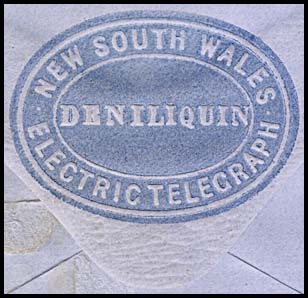 Scan of embossed oval on flap of envelope. Provenance: De La Rue Archives, Gundersen, Johnstone. |
|
The earliest indication of the operation of the Deniliquin Telegraph Office is a message on a telegram delivery form (VC-DO-11B) at Sandhurst on 29 September 1884 from Deniliquin - hence about 23 years after the Deniliquin Telegraph Office became operational under government control. |
|
| Date stamps.
Only one tpe of date stamp was issued to the Deniliquin Telegraph Office for use with Telegraphs (and ordinary mail) - a TELEGRAPHS DENILIQUIN date stamp (SC1-T). |
|
Used: 22 October 1946 to 21 October 1950. |
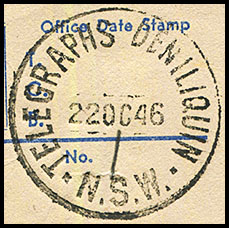 22 October 1946. Used on AW-DO-10 (43). |
| The usual Deniliquin postal date stamp was also used on telegrams and telegraphic Money Orders. | 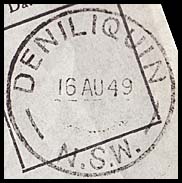 16 August 1949. Used on a Telegraphic Money Order |
|
Personnel: November 1925: Mr. J. Miles, Manager of the Telegraph Office at Dubbo was appointed Postmaster at Griffith. |
The Telegraph Office opened on 7 May 1864 under the supervision of Mr. Middleton. It combined with the Post Office on 23 December 1870. The Post Office had been opened as Lang's Crossing Place on 1 April 1859. The location was an important crossing place over the Murrumbidgee River en route to the markets in Victoria. The town was renamed Hay in October 1859 and, on 22 February 1861, the Post Office also had a name change. The present Post Office is on the site of the former goal built in 1860. The Wagga Wagga Express of 15 October 1859 addressed the important community issue of the change in name: "HAY OR WARRAGERI. The speculations as to why this place is to be called Hay are still very numerous and the dislike to the name seems to be universal amongst all classes of society. Some persons imagine that the Minister for Lands and Public Works employed his last vacation in learning a number of nursery rhymes, intending in future to adorn his speeches with numerous quotations and astonish honourable members with the extent of his learning. Having with great assiduity committed to memory the verses commencing with
he could not afterwards keep the jingling sound out of his head and, although intending to call this place Warrageri, was not able to resist Hay - the words "heigh! diddle, diddle" coming into his mind so strongly just as he took his pen in hand. It is also thought that Lang's Crossing Place may have been called after Mr. Hay, because he takes an interest in bridges and will be likely to support a motion for bridging the Murrumbidgee at this spot. However this may be, it is quite certain that the new name will be continually murdered and that we shall hear conversations somewhat in the following style:
The Pastoral Times of 18 June 1864 noted that the Hay telegraph line "is paying as well as its supporters expected. It will be remembered that the Government of Sydney refused to construct the line, unless some parties possessing means became responsible for a return of five per cent, on the outlay — viz., cost of line and working expenses. The line and the station cost between £5,000 and £6,000 and the eight persons who have become sureties will not, it is apprehended, have much to make up, even if the Government is shabby enough to call upon them to do so. Considering, however, that so little is done by the Government for the Riverine districts, and bearing in mind the large amount of revenue they receive from us, they will "cap the climax" if they call upon the Hay men to make up any deficiency that may arise in relation to this line". The Riverine Grazier of 30 May 1877 addressed the alterations and additions to the Post and Telegraph Office: "We are informed that a clock is to be placed in the front of the Post and Telegraph offices, at the same time as the alterations and additions are made. We do not know where our informant obtained his information or whether, having seen a clock shown on the plans for the alterations, he has taken it for granted that the clock is to be included in the improvements. One thing is certain, however, that a clock such as we refer to is very much required at Hay. A striking instance of the value of a public clock was brought to light the other day, when a gentleman who had travelled to Hay with the object of purchasing a large area of Crown lands at auction, was too late for the sale, through a misapprehension as to the correct hour of day. The purchase of the land in another way (selection after auction) involved an extra expenditure of some hundreds of pounds sterling, which would most probably have been saved him had there been any public recognised timepiece". 4. Location of the new Telegraph Office. It appears that the Post and Telegraph Office may have been better situated. The Riverine Grazier of 15 August 1877 noted: "Mr. Moyse, Postal and Telegraph Inspector, is expected to visit Hay within the ensuing eight days. The opportunity ought not to be lost sight of to enlist that gentleman's good services in securing some considerable emendation of the plans for the additions and alterations to the local Post and Telegraph offices. Otherwise, so far at least as the colonial architect appears to care, these offices will be allowed to remain in a water hole - where they will he surrounded by the drainage from the adjacent property, and the adjoining new court house, the floor of which is three feet above that of the Post Office. We fear that, owing to the bad season, and the corresponding scarcity of teams, with a low river, Mr Baker, contractor for the telegraph extension to Booligal, will have considerable difficulty in making arrangements for the supply and conveyance of material for the erection of the line. We understand that he is prepared to let a contract for the supply of telegraph poles, delivered at Hay or on the line, and mention this in the hope that it may meet the eye of some contractor who may not have seen Mr Baker's advertisement inviting tenders". |
||
|
||
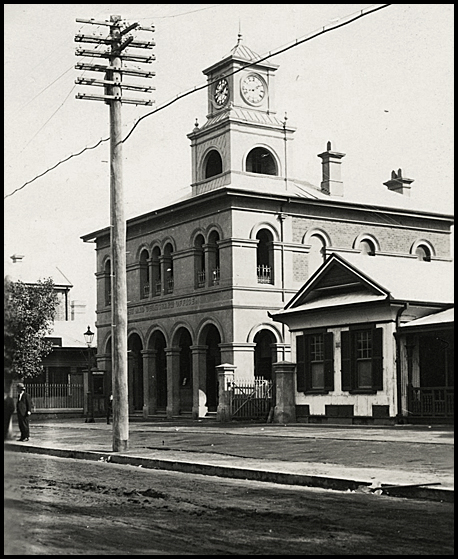 |
(Above): Hay Post & Telegraph Office with the Department of Lands building to the right. |
|
| Even before the telegraph line had been completed, the financial benefits were being anticipated. For example, the Argus of 3 July 1863 carried an advertisement for the sale of the Argyle Hotel which noted, in addition to the facilities, "its close proximity to the Murrumbidgee and to the terminus of the Deniliquin and Hay Telegraph Line renders it a most desirable investment, it being the only hotel in Hay suited to doing a first- class trade".
On 14 September 1872, the Australian Town and Country Journal, in a story about Hay noted:
The Riverine Grazier (printed in Hay) of 9 December 1882 reported: "After the usual unaccountable delay in the passing of public works by the department, the new Post and Telegraph offices have been approved and Mr Burnett has lost no time in taking possession of them. Business was commenced yesterday morning in the new building". As an aside, the Australian Town and Country Journal of 10 June 1882 reported on preparations for the celebration of the opening of the railway to Hay. In part: "Our overworked chief of the patent telegraph poles has promised to light up the banquet hall with an 8 h.p. electric light, if the Arrangements' Committee provide a sufficiently powerful engine. The commitee seemed disposed to get rid of the offer, on the plea that the electric light has a demoralizing effect upon female beauty. They need not fear anything of the kind from any light our Telegraphic Department may show although, an eight-gallon case of kerosene is more likely to give sufficient and effective light than any other appliances they can get from Sydney". 7 May 1864: Mr. Middleton appointed Station Master of the new office. July 1876: Mr. Arthur Harding Murray, Messenger at Deniliquin, was transferred to be Junior Operator at Hay. 6 June 1879: Mr. T. A. Murray, the junior operator at Hay, was transferred to be the operator at Bourke.
|
||
|
The Telegraph Office opened on 26 June 1878 and was merged with the Post Office on 10 May 1880. The Ovens and Murray Advertiser of 20 June 1878 reported "The Government has determined that an office for the receipt and dispatch of telegrams shall be forthwith opened at Howlong. The adoption of these two steps (for Howling and Corowa) will be hailed with the utmost satisfaction on the part of the public". |
| Jerilderie.
The Telegraph Office opened on 4 May 1866. It changed name from Jereelderie on 10 January 1890. The Pastoral Times of 29 August 1868 reported " We regret to hear that the telegraph office at Jerilderie is closed owing to want of support — the guarantors having declined to supplement the local receipts — still the office can be opened at any future time when prospects are better than at present". On 19 September, the Times followed up this article with: "There was a Telegraph Office opened at Jerilderie on the guarantee principle. Five local persons guaranteed to the Government to make up any deficit between the gross receipts and and the gross costs of the office, but recently the guarantors had to pay £20 each to make up the deficiency. Having, I suppose, "done enough for fame", the guarantors declined to be mulcted any more, so the office was closed. I hear that the receipts were £120 for the year—the Government might very well place a line-man at Jerilderie capable of sending messages — the expenses of the electric telegraph working are far too heavy for these road-side stations and I cannot see on what just principles the Government can expect any men to guarantee a deficiency in these cases, seeing that the Government receives such large sums of money for land sales, rents assessments, publicans' licenses, etc". This situation in Jerilderie was the catalyst for the proposal of a possible alternative strategy for the guarantee system- described elsewhere. That actually raised the suggestion that women could be employed in Telegraph Offices as electricians - even at Jerilderie. Good things happen - and in December 1878, with little apparent fanfare, a tender to construct a Post and Telegraph Office at Jerilderie was awarded to Mr. P. J. D'Arcy. The Kelly Gang held-up the Jerilderie branch of the Bank of New South Wales in February 1879 and, while in town, inflicted considerable damage to the wires, insulators and the telegraph poles. See elsewhere for the story. Personnel: June 1866: Mr. Thomas Trader, junior operator at Braidwood was appointed Station Master. December 1874: Mr. Henry Jefferson was appointed Station Master to replace Mr. Daniel Ryan Kenane who was transferred to Burrowa. |
|
|
|
|
|
|
A Post Office opened at Junee on 1 May 1862, It closed on 2 September 1878 only to open the next day as a Receiving Office. It changed name to Old Junee on 16 July 1881 and became the Post Office at the Railway Station. From 19 June 1909, it also acted as a telephone station with telegraph responsibilities. On 1 May 1913, it became a Post and Telegraph Office and was removed from the Railway Station. On 6 July 1878, a Telegraph Office and Receiving Office were opened at the Railway Station. That Office changed its name to Junee Junction on 16 July 1881 and then to Junee Post and Telegraph Office on 1 November 1893. In November 1887, a tender was awarded to Galty and Flook for the construction of a Post and Telegraph Office. |
|
|
Close to the border with Victoria and north-west of Mulwala,Yarrawonga, a Post Office was opened at Lalalty on the change of name from Naranghi on 1 August 1900. That office was closed on 31 March 1910. On 24 May 1922, a Telegraph/Telephone Office was opened followed later by a Post Office which operated from 1 January 1927 to 1 August 1930. The joint telegraph/telephone office continued to operate until it was destroyed by fire on 13 February 1939. It was closed on 10 March 1941. It then operated until 7 May 1957 as a Rural Automatic (Telephone) Exchange.
|
||
| The telegraph section of the joint office was issued with a very unusual date stamp for use with telegrams. It was engraved T. O. K. Lalalty - the initials standing for Telegraph/Telephone Office Keeper.
|
 12 April 1939. |
|
| Moama.
Moama is directly across the Murray from Echuca. It had been the Victorian Post Office of Maiden's Punt from 1848 to 1855 when it was transferred to NSW. The Post Office changed name to Moama on 1 January 1858. Unfortunately the Post Office was destroyed by fire in December 1861. The first Telegraph Office opened in Moama on 24 March 1859 together with the Telegraph Office at Deniliquin. The line from Echuca and the Telegraph Station were organised and paid for by the people of Moama and Deniliquin as a private enterprise. See the full story elsewhere. The "State Owned" Telegraph Office was opened at Moama in May, 1862 by William Camper when he was transferred from Kiama. In contrast, the Echuca Telegraph Office on the other side of the Murray River had opened in December 1858. Mr Camper remained in charge at Moama until March, 1867 when he accompanied Superintendent Cracknell to Wentworth to establish a border repeating office linking up the South Australian, Victorian and New South Wales lines. |
The Bendigo Advertiser of 9 June 1859 reported: "MOAMA
The Riverine Herald of 11 November 1879 reported:
Personnel: May 1867: Mr W. Camper, Station Master at Moama was appointed as Station Master to open the new station at Wentworth. June 1867: Mr. W. Nash was appointed Station Master. November 1867: "It has been found necessary for his own safety to place Mr. Pizey, late Telegraph Station Master at Moama, under restraint. According to the Riverine Herald, "of a weak constitution and suffering very frequently from epileptic fits, Mr. Pizey became very much alarmed at the high flood in the Murray, and was very apprehensive of meeting his death by drowning. To such an extent did his fears carry him, that it was deemed best to place him in the charge of the police. Medical assistance having been obtained, an examination confirmed the supposition that he would be best under the watchful care of some responsible person. He has since been removed to Deniliquin" (Yass Courier 9 November 1867). September 1877: Mr. Albert Davies, who had held the position of Post and Telegraph Master at the Moama Post and Telegraph Office "to the entire satisfaction of the public" was promoted to be the first Post and Telegraph Master at Wilcannia. "The Wilcanniates will receive a highly efficient and obliging public servant". |
|
Moulamein was the original township of the Edward district but, owing to some influence parliamentary and otherwise—that description was reserved for Deniliquin to have its greatness thrust upon it. The Goulburn Herald of 25 April 1866 noted that "the Acting Superintendent of Telegraphs had passed through Goulburn on his way to open the new Station at Moulamein on the lower Murray. It was expected that the line from Adelaide to Wentworth will be ready for use in about six weeks and from Moulamein to Wentworth in about three months from the present time". The April date is probably for when the connection was being made and so the station would not be handling public telegraphs. The opening date of 9 May 1866 is probably correct for the opening to the public. Of course, given the shortage of time, the Telegraph Office would only be opened in temporary quarters probably at the Town Store or at the Court House. The Empire of 23 July 1866 reported that tenders had been called for erecting telegraph stations at Euston, Moulamein and Balranald. In the Legislative Assembly on 16 April 1868, £1,600 was placed on the Estimates for the construction of a Telegraph Station at Moulamein. |
|
| Personnel:
March 1870: Mr. Olsen was transferred to be Acting Postmaster at Deniliquin when Mr. Kraegen left.
|
|
Early usage: The earliest evidence of the operation of the Telegraph Office ay Moulamein is the printing of a special delivery envelope by de la Rue. |
|
Moulemein was one of the 29 Telegraph Offices included in the special printings of delivery envelope NC-EO-3. These envelopes incorporated an embossed oval seal (EO6-ET) on the flap of the envelope with NEW SOUTH WALES at the top and ELECTRIC TELEGRAPH at the base. The office name was embossed across the centre of the seal.
|
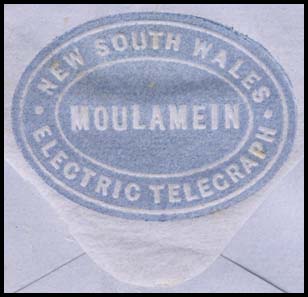 Scan of embossed oval on flap of envelope. Provenance: De La Rue Archives, Gundersen, Johnstone. |
| Narrandera.
On Friday 19 May 1876, the Assembly agreed to place on the estimates £800 for a Post and Telegraph Office at Narrandera. The Telegraph Office opened at the Post Office on 24 July 1876 and the two offices merged on 1 September 1876. The Post Office had originally opened on 1 October 1861 with a change of name from Gillinbah. Tenders were called in the Gazette in November 1879 for the erection of a Post and Telegraph Office at Narandera closing at the end of that month. An excellent history of Narrandera and the surrounding area is given elsewhere. On 10 July 1900, the Daily Telegraph reported "The new Post and Telegraph Office now in course of construction is being pushed on by the contractor. A Ministerial parly is being invited for the ceremony ot laying the foundation stone at an early date". Personnel: 7 July 1876: Charles Chapman, a junior operator at Wallsend was promoted to be Station Master at Narrandera. 27 November 1878: the second person to be appointed to the Narrandera P&T Office was the telegraph messenger. |
||
A rubber circular Telegraph Office date stamp (RC3 - TO) was provided for use with Telegrams.
|
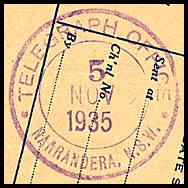 5 November 1935. |
|
|
Tocumwal is just on the border with Victoria. A Telegraph Office operated at the Railway Station from 1 May 1937 to 31 August 1967. |
|
A Telegraph Office was opened at Urana (between Wagga Wagga and Deniliquin) on 29 October 1861 (N.S.W. Annual Report for 1862) about 7 months after the Post Office had opened. The two Offices were combined on 8 November 1869. It is presumed that there may not have been any dedicated building for the combined operation. In August 1876, £800 was voted by Parliament in the Appropriations Act for the construction of a Post and Telegraph Office at Urana. On 15 September 1877, the Ovens and Murray Advertiser followed that up by noting "Some annoyance is expressed at the delay of starting the Post and Telegraph office (at Urana) and the Court House, the contract of which was let to Mr Hardy of Wagga Wagga; but from what can be ascertained, there is some dispute between the contractor and the Government about the details of the specifications. It is to be hoped that the two offices will soon be in course of erection as the present edifices are unfit for the business transacted in them". |
Early use. The earliest evidence of the operation of the Urana Telegraph Office is:
|
When early discussions were still proceeding, the Wagga Wagga Express of 21 May 1859 showed how keen the locals were in having the telegraph connected: "Captain Martindale arrived here last Saturday on his way to Albury. The Commissioner, we believe, is on an official tour of inspection; and it is to be hoped that the result of his journey through the Southern District will be some speedy improvements upon our great highway. His enquiries into the progress of our telegraph project led to a spirited offer by Mr. T. Byrnes of building two rooms for an office and giving the Government the free use of them for a term of three years". The telegraph wire reached Wagga Wagga at the beginning of January 1861. On 12 January 1861, the Express ever so politely wrote "No official intelligence of the when and where of the proposed Telegraph office has as yet reached Wagga Wagga although two offers of suitable buildings have been made to the authorities and Mr. P. A. Thomson has signified his willingness to provide for the transit of the necessary instruments. One would imagine that the wire being complete, it might be advisable to make it remunerative even if the convenience of the public were not taken into account. But verily the mysteries of the circumlocution office are inscrutable". The Telegraph Office was opened on 10 June 1861 and merged with the Post Office in 1868. In advance of that merger, tenders were called in the Gazette of 2 June 1868 for the construction of a Telegraph Station and a Post Office. In July, the Government accepted the tender of Mr. J. Markell for the erection of a Telegraph and Post Office at Wagga Wagga. On 12 December 1868, the Wagga Wagga Advertiser described several of the building developments in the town. In part, they noted "A neat cottage is being built as a private residence for Mr. Chapman, near that gentleman's mill, and tenders have been called for the erection of a large cottage on the allotment adjoining the office of this paper. Then there is the peculiar Post Office and Telegraph building which is perpetually being worked at yet never seems to get any nearer completion. It is a most unpleasant state of things for all concerned:
In the Legislative Assembly of 28 January 1869, £1,971 10s was placed on the Estimates for the erection of a Post and Telegraph Office at Wagga Wagga. BUT - the Goulburn Herald of 29 December 1869 reported: "At last it has been resolved to put the new Post and Telegraph Office to the use for which, some six months ago, it was built. The fittings, etc., of the old office have been removed to the new, where the business during the week has been conducted, infinitely to the comfort and satisfaction both of the officials and the public". The Post Office had opened on 1 January 1849. |
|
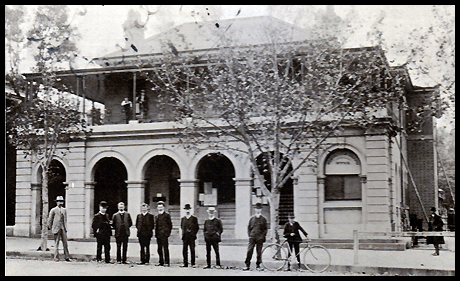 |
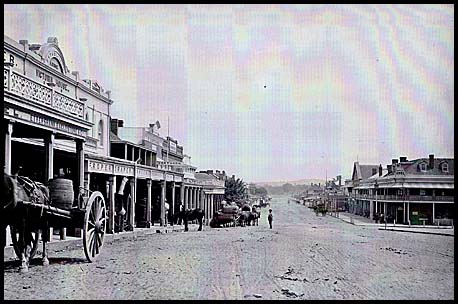 Fitzmaurice Street, Wagga Wagga about 1880. Fitzmaurice Street, Wagga Wagga about 1880. |
The Gazette of 22 June 1877 announced acceptance of the tender submitted by Mr. C. Hardy for the erection of the Post and Telegraph Office at Wagga Wagga. On 10 October 1877, the Gazette called for tenders to erect a Clock Turret at the Post Office in Wagga Wagga. The Wagga Wagga Advertiser printed the following on 18 July 1882: "A meeting of the Progress Committee will be held at the Australian Hotel on Thursday evening, the 20th instant, at 8 o'clock, to consider the advisability of moving for the erection of a new Telegraph Office and for the purchase or resumption of the land next the Commercial Bank as a site; and also to urge upon the Government the pressing necessity for making immediate temporary provision for the service by the removal of the offices to other premises". Perhaps a speedy reaction after only a very short five years - on 29 April 1887, notice was given in the Gazette of the resumption of a portion of land in the parish of South Wagga Wagga, town of Wagga Wagga, in connection with the erection of a Post and Telegraph office. 3. Floods and the Wagga Wagga Telegraph Office. Floods were common in Wagga Wagga in those days. In June 1867, significant flooding occurred which exceeded the 1864 levels. The Goulburn Herald of 3 July 1867 carried a full description of the first few days. Also included is the detail of an heroic rescue of six chinese vegetable gardners who had become isolated. A rescue party of four brave men (which included the Telegraph Station Master Mr. John Quodling) set out - at great personal risk - at night in a boat and managed to rescue the chinese from their fate. During the floods of October 1867, frequent telegrams were sent from Gundagai to Wagga Wagga informing them of river heights. To remember how important the telegraph was in times of emergency, extracts related to the telegraph in that major flood are included: The Sydney Morning Herald of 16 October 1867 reported "by telegram from Gundagai, it was then known the flood had reached the level of the June flood, the coming inundation was seen to be inevitable. During Monday the waters still rose though not so rapidly as had been anticipated and that night they flowed over the bank and found their way into the lower portions of Fitzmaurice Street. On Tuesday morning, the occupants of the Prince of Wales and Squatters' Hotels and many other buildings were flooded out. The Bank of New South Wales was surrounded and the highest floors upon the premises covered several inches deep ... The Post Office was swamped early in the day, and the letters and papers were hastily removed to a room in the Pastoral Hotel which was constituted as a temporary Post Office for the occasion. In the afternoon telegrams were received from Gundagai conveying the welcome intelligence that the river had fallen at that town and the apprehensions of the people were, in a measure, relieved. But as the waters still crept steadily up the gauges, which each anxious householder had placed opposite his door, it was impossible not to experience some feelings of disquietude and, when night closed in, there were few who thought of retiring to their beds. The whole river valley was then transformed into a sea of water, flowing through and against this, trees which impeded its course with a heavy ceaseless roar which the stillness of the night air rendered doubly impressive to the groups upon the footpaths who were patiently watching the rising flood. A little after midnight, to the relief of all, the rising ceased, and the waters soon after began gradually to abate, having attained a greater height by four inches than last June ... below the town the river was four miles wide on Tuesday ... The Kyamba Creek Bridge was covered above the hand-railing but, in spite of the current and the insecurity of the structure, the mailman succeeded in crossing it, a plucky act which places in striking contrast the conduct of the contractors on the main line between Gundagi and Tarcutta, who have coolly detained our mails whenever they have deemed it inconvenient to travel ... The police boat has rotted away and is now comfortably reposing in the bed of the river. Are the police to be ever again supplied with another or will it be necessary to wait until valuable lives have been sacrificed before the urgency of the want will be admitted? We stated last week that it was impossible to ascertain the correct level of the river at Gundagai owing to the want of a proper gauge. We have since been informed that a gauge has been fixed there for some time and that a daily record of the river level is kept. The information thus gained will no doubt prove extremely useful hereafter but, for people residing here and lower down the river, the gauge, at the times it is most wanted, is never likely to be of much service as it is fixed on the south bank of the river while the telegraph office is situated on the north. In times of flood communication between the two, is sure to be irregular and uncertain". The telegraph staff across all Colonies were generally an inventive mob and keen to try new things. Hence, according to the Albury Banner of 30 March 1878, "A very interesting series of experiments have been made with the telephone by Mr. C. A. Middleton, our local telegraph master, in conjunction with Mr. McGaurin, of Albury. It has been expected for some time back that a message uttered in Albury could be distinctly heard in Wagga Wagga and vice versa, and last week this result was achieved. The distance from here to Albury by wire is about 125 miles and, we are informed, that is the greatest distance that has been spanned by vibration of the telephone". Although nothing to do with the Telegraph Office, a comment on the news of the day in December 1869 deserves to be retold: "In Wagga Wagga recently a little girl came to her mother with a black snake about two feet in length firmly gripped in her hand by the neck. On throwing it down the reptile made off. Fortunately the girl was not bitten". And another story off-the-track: On 26 March 1881, Wagga was lit with gas for the first time. 5. Upgrading the Office capabilities. Forward to the next century the Daily Advertiser of 5 June 1915 carried the following: "The Wagga Post and Telegraph Office at present is the third in importance in the State on a revenue basis and from next week the status of the office is to be advanced very considerably. As a step towards eliminating telegraphic delays, the department recently decided upon the creation of five repeating centres outside the G.P.O. at Sydney. Wagga, Dubbo, Armidale, Lismore and Deniliquin were selected for the experiment. It is an important move in decentralisation and, if as successful as the experts forecast, the public convenience will be greatly served. Mr. L. V. Miller, Post Master, has been advised that ihe staff of the Wagga Office will be strengthened by the addition of six men from Sydney, making a total of 12 operators. The whole of the business from stations Albury to Wagga to Hay, and all through Western Riverina out to Menindie and White Cliffs, and all the surrounding towns north of Wagga, will be sent into Wagga and from here despatched to Sydney and other centres. Four operators will be constantly engaged working a quad set of instruments with Sydney - two sending and two receiving - whilst other operators will be taking business over the lines and feeding to the quad set. Mr. Miller and Mr. Smith (first telegraphist) have been busy for the past day or two arranging details for the introduction of the new system from which so much is hoped for by the department. On Tuesday morning the new system commences and the Wagga office will be one of the busiest in the Commonwealth". The use of Wagga Wagga as a repeating station preceeded this announcement - see for example the telegram sent from the Caulfield Races in August 1913. |
|
|
May 1861: Mr. Andrew McCracken was appointed Station Master and Line Inspector. June 1867: Mr. E.D. Scott Jnr. was appointed Line Repairer. May 1868: Mr. Alexander H. M. McGregor was appointed Electric Telegraph Station Master. The Sydney Morning Herald on 9 June 1868 reported:
Two appointments to Wagga Wagga were announced in July 1868 upon the merger of the Telegraph and Post Offices:
The Wagga Wagga Express of 26 October 1872 commented as follows: "It has been reported about town that Mr. C. Middleton, who has conducted the business of the Post and Telegraph offices during the past four years, had received a communication from the head office, asking him whether he would wish to take charge of the Albury station. We cannot say what Mr. Middleton's own wishes upon the subject may be, but we sincerely trust that he does not contemplate the change, and the hope will be endorsed, we feel satisfied, by every one who knows that gentleman in his official capacity or private character. The duties of the office, which are of an exceedingly onerous nature, could not possibly be performed more efficiently than by him, and we are certain that any change which took place in the management of the respective departments, must, of necessity, be for the worse". September 1873: Mr. Thomas Trader was transferred to Bourke to open the Telegraph Office there. March 1874: Mr A. D. Turner was appointed as junior operator. For a reference to the Telegraph Messenger in 1875, see elsewhere. July 1878: "It is with extreme regret we chronicle the death of the only son of Mr. Unwin - a gentleman who has recently arrived in Wagga Wagga from Sydney to be in charge of the Postal and Telegraph Departments. The child was only about six years of age and succumbed to a very severe attack of inflammatory croup. Medical aid was called in and everything done to relieve the sufferings of the child but death ensued on the night of Sunday. Much sympathy is felt for the sorrowing parents. (Wagga Wagga Advertiser 17 July 1878). March 1879: Mr. James Johnston, a Junior Operator at Braidwood, was promoted to Operator at Wagga Wagga to replace Mr. Hogan. A Letter to the Editor of the Australian Town and Country Journal of 27 September 1879 noted that:
April 1883: Mr. H. Hoare, Messenger at Head Office was promoted to be Operator at Wagga Wagga. |
|
The earliest evidence of the operation of the Wagga Wagga Telegraph Office is:
|
|
1. Wagga Wagga was one of the 29 Telegraph Offices included in the special printings of delivery envelope NC-EO-3 by de la Rue in 1858 These envelopes incorporated an embossed oval seal on the rounded flap of the envelope with NEW SOUTH WALES at the top and ELECTRIC TELEGRAPH at the base. The office name was embossed across the centre of the seal.
|
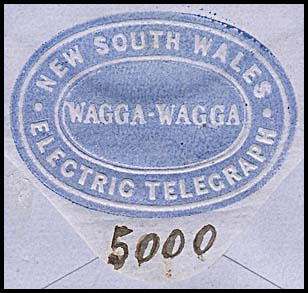 Scan of embossed oval on flap of envelope. Provenance: De La Rue Archives, Gundersen, Johnstone. |
| 2. a South Australian delivery form (SC-DO-4A) used to record a message sent from Wagga Wagga to Adelaide Station on 20 April 1876. | |
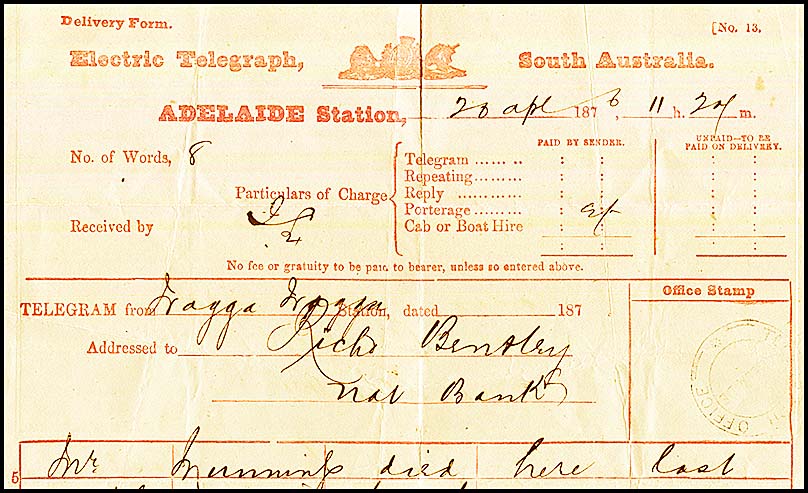 |
|
| Date stamps:
Two formats of a TELEGRAPHS WAGGA WAGGA date stamp were used. |
||
|
|
|
|
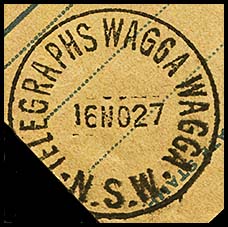 16 November 1927. Used on AB-DO-4A. |
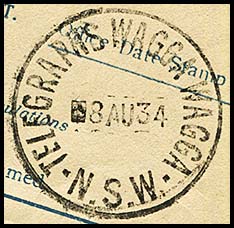 17 July 1934. Used on AB-DO-7Ba. |
The usual Wagga Wagga postal date stamp was also used on telegrams. This format changed over the years.
|
|
||
In July 1940, a new Telephone Exchange was opened in Wagga incorporating the most modern telegraphic equipment. From then, telegram messages could be automatically repeated from outlying centres, cities and towns direct to Sydney without having to be repeated by telegraphists.
A Telegraph Office was opened as Wagga Wagga Rail Telegraph Office on 20 May 1895. It closed on 31 August 1948. |
| Wentworth.
The Telegraph Office opened on 21 September 1860 when the former Telegraph Office at Moorna was renamed Wentworth. In August 1865, the Gazette announced that "The tender of Mr. A. McAuley for the erection of a telegraph repeating station at Wentworth has been accepted by the Government". It is very difficult to give a date on which the Telegraph Office opened at Wentworth:
When construction of the inter-Colonial line linking New South Wales and South Australia was completed in 1867, a new Telegraph Office was constructed at Wentworth. During the construction, the Pastoral Times of 26 January 1867 commented "the offices here will soon exhibit signs of speedy completion, the front walls being up to the required height. Speaking of the walls reminds me of a great error, and which is noticed by all persons the least conversant with the subject, that has been committed by the architect. The operating room has only a wall of twelve feet high, the other offices ten feet. In a climate like ours, where ventilation is so requisite, two feet additional height at the very least should have been given, besides this, the present height will mar the effect of the building when finished to a considerable extent". Tenders were called for the construction of Postmaster's Quarters and a replacement Post & Telegraph Office on 18 July 1898. |
|
|
|
Wentworth was one of the 29 Telegraph Offices included in the special printings of delivery envelope NC-EO-3. These envelopes incorporated an embossed oval seal (EO6-ET) on the flap of the envelope with NEW SOUTH WALES at the top and ELECTRIC TELEGRAPH at the base. The office name was embossed across the centre of the seal.
|
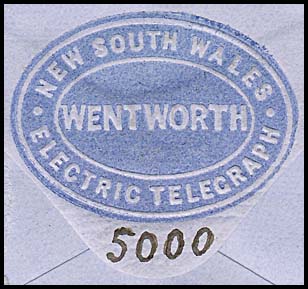 Scan of embossed oval on flap of envelope. Provenance: De La Rue Archives, Gundersen, Johnstone. |
Personnel: May 1867: Mr W. Camper, now Station Master at Moama was appointed as Station Master to open the new station at Wentworth.
May 1877: Mr Patrick Thomas Whealey of Urana has been appointed as Junior Operator in the Telegraph Office. November 1879: Master W. Parker (eldest son of Sergeant Parker), who had for the past three years been engaged as probationer of the Cootamundral Telegraph Office, was promoted to the Wentworth office, where he filled the duties of junior operator. |
|
